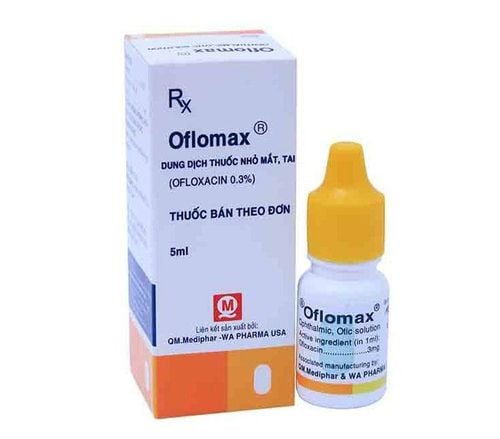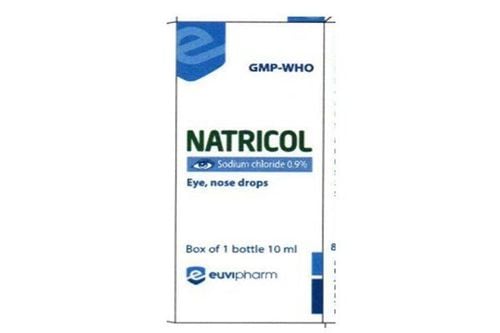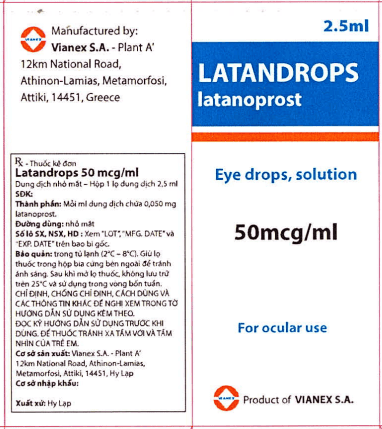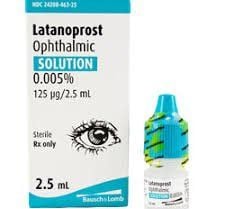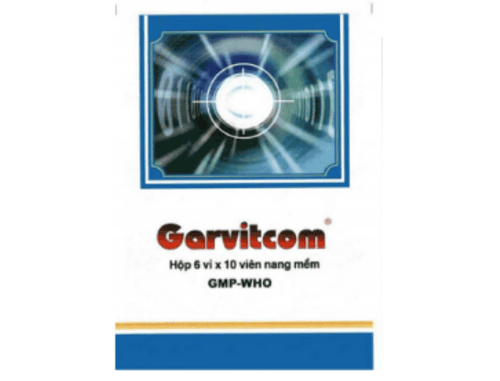This is an automatically translated article.
The term entropion describes the inward curl of the eyelid margin into the eyeball, or the inward curvature of part or all of the ciliary cartilage, which pulls the eyelash roots and eyelashes inwards to touch the eyeball, causing irritation. likes eyeballs. Entropion can occur in both adults and children. Let's read more articles below to understand more about entropion in children and adults.
1. What is the condition of the eyelids?
Entropion is a condition in which the eyelids curl into the eyeball causing the eyelashes and skin to rub against our cornea and conjunctiva, causing itching and discomfort. The condition of entropion often occurs in the lower eyelids and is common in adults (over 60 years old) as a result of the loss of orbital fat, which causes the eyes to be concave, which is a prerequisite for entropion. Sometimes entropion can also appear in young children at birth, also known as congenital entropion. For young children, entropion affects a child's health a lot, it can damage the cornea and lead to vision loss in the child if not treated early.
The disease can cause the eye or the area around the eye to become red, irritated, and scratch the cornea, making the patient uncomfortable and painful. If this condition is easy to deal with and is not treated in time, it will lead to corneal scarring, increasing the risk of corneal ulcers, even more dangerous, vision loss and complete blindness.
There are many diseases and diseases in the eyes that have the same condition as entropion, it is necessary to distinguish congenital entropion as follows;
1.1. Excess skin folds, also known as congenital pseudo-crystallosis, is an abnormal growth of the skin, characterized by the appearance of a fold of skin that runs across the upper or lower eyelids, causing the eyelashes to shift. toward the surface of the eyeball. In order to distinguish between congenital entropion and excess skin folds, the position of the eyelid margin needs attention. Excess skin folds: The lashes do not rub against the cornea unless the eye is looking downwards. Hyperpigmentation usually does not require treatment as it resolves on its own within the first 2 years. 1.2. Distinguishing congenital entropion from children with lacrimal obstruction These two conditions are characterized by prolonged tears and discharge in the eyes, but in children with blocked tear ducts, they do not cause red eyes. When examining often children are uncoordinated and cry a lot, eyes closed, doctors can misdiagnose with congenital entropion. A thorough examination in combination with lacrimal irrigation can help in the differential diagnosis of congenital entropion.
1.3. Distinguishing Congenital Tinnitus from Double Lashes. The outer appearance is similar to the arch of the eyelids. This malformation can be present alone or in association with other congenital abnormalities, and many researchers have suggested that the disease is related to autosomal recessive inheritance.
When eyelashes often rub against the cornea and conjunctiva, it will lead to many recognizable symptoms of entropion such as:
Red eyes Irritation or pain in the eyes Sensitivity to light and wind Watery eyes with constant frequency Continuous crusting of eyelids and mucus discharge A feeling of gritty sand in the eyes Pain when seeing bright light Decreased vision There are many degrees of entropion that can be easily diagnosed and treated by specialists. divided as follows;
Level I: Enemy occupies 1⁄4 of the length of the lash line. Level II: Enemy occupies 1/3 of the length of the eyelid margin. Level III: Enemy occupies 1⁄2 of the length of the eyelid margin. Grade IV: Encrusted occupies 2/3 of the length of the lash line to the entire lash line. For the degree of encroachment calculated by experts by excess eyelid skin, it will be divided as follows:
Grade I: Excess of about ≤ 2mm of eyelid skin. Grade II: An excess of about 3mm of eyelid skin. Grade III: An excess of ≥ 3mm of eyelid skin.
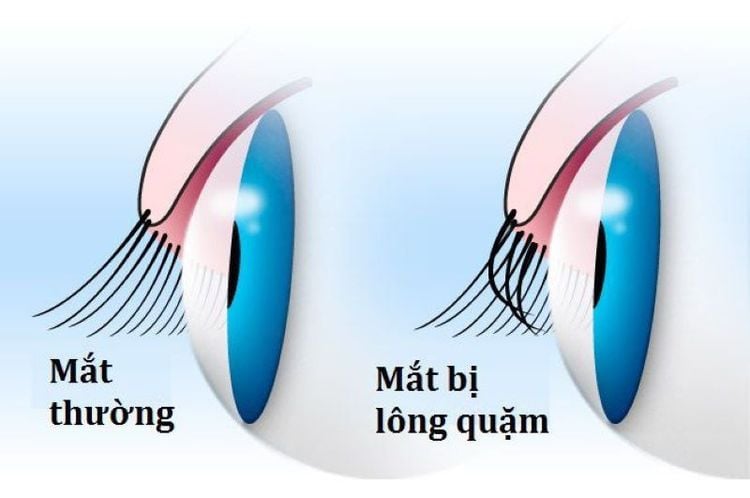
Quặm mi mắt là tình trạng cuộn bờ mi vào trong nhãn cầu khiến lông mi và da cọ xát với phần giác mạc và kết mạc
2. Causes of entropion in children and adults
There are many different causes of entropion in children and adults, including the following typical causes:
2.1. Congenital entropion Congenital entropion is a phenomenon where the eyelids turn inward, pushing the eyelashes against the cornea, due to structural defects of the ciliary cartilage, hyperplasia of the sphincter and the skin layer seen in newborns. The disease progresses more and more seriously if not treated, causing corneal ulcers that leave scars, affecting the children's long-term vision.
2.2. This is the most common cause, occurring due to the aging skin process, causing the tissues that support the eyelids to become loose. Eyelashes are pulled inward causing itching, discomfort, tearing, red eyes...
2.3. Squint due to spasm Usually occurs in the lower eyelid. Patients with trauma after surgery or with inflammation in the eye may have chronic eyelid spasm, prolonged squinting, causing the eyelid margin to roll inward, causing trichiasis.
2.4. This is often a complication of diseases of the conjunctiva and eyelid cartilage such as trachoma, Stevens - Johnson syndrome, chemical burns, eye Pemphigus disease... The eyelid cartilage is then bent inward, the conjunctival conjunctival You will have scarring, sometimes with partial adhesions.
2.5. Muscle weakness As we age, the muscles under the eyes tend to weaken, and ligaments stretch. This is the most common cause of entropion.
2.6. Due to scarring or previous surgeries The skin around the eyes can be scarred from chemical burns, trauma, or surgery that can distort the normal curvature of the eyelids.
2.7. Eye infections Infections or trachoma are common in many developing countries of Africa, Asia, Latin America, the Middle East and the Pacific islands, of which the population of Vietnam has a high prevalence. trachoma is quite high. It can cause scarring of the inner eyelid, leading to entropion and even blindness.
2.8. Inflammation When we rub our eyes or close our eyelids tightly due to eye irritation due to dryness or inflammation, this can lead to contraction of the eyelid muscles and inward roll of the eyelid margin, causing damage to the cornea (colic spasm).
2.9. Developmental complications Congenital entropion can be caused by an excess skin fold on the eyelid that causes ingrown eyelashes.

Bệnh quặm mi mắt do tuổi già là nguyên nhân phổ biến nhất, xảy ra do quá trình lão hóa da
3. Treatment and prevention of entropion
Treatment of congenital entropion in children under 1 year of age, the child's eyelashes are not hard enough to damage the cornea, so the doctor can prescribe the child to apply the medicine (normal saline solution 0. 9% or an antibiotic solution such as tobrex). In addition, doctors also need to guide young parents on how to stroke the eyelids in order to make the eyelashes pop out, the eyelashes do not rub against the cornea to avoid damage to the cornea. However, if the condition does not go away on its own, you can wait until the child is older to have surgery.
Congenital entropion surgery performed at eye hospitals is a relatively simple surgery with a short surgical time, leaving no cosmetic scars. After the operation, if the child has abnormal symptoms such as rubbing his eyes, watering his eyes, it is necessary to take the child to the ophthalmology facility for examination and treatment as soon as possible.
For entropion in adults, due to old age, it is common to have entropion of the lower eyelid due to the concave eyes due to the loss of orbital fat, losing the back support of the eyelids, causing the eyelid margin to fall back and inward. Eyelashes rub against the surface of the eyeball, causing tears and eye discharge. Eyelashes can rub against the cornea, causing prolonged keratitis. Treatment of eyelid entropion in adults is as follows:
The treatment of entropion is to eliminate or reduce the causes of the condition such as performing eyelid shortening surgery to treat drooping eyelids in combination with reestablish the attachment of the lower eyelid traction muscle or eliminate the causative agent of the spasm.
Use some artificial tears or prolonged eye ointment:
Treatment of conjunctivitis, trachoma such as antibiotics, anti-inflammatory. Eye care with artificial tears. Gently massaging the area around the eyelids regularly is also effective in reducing discomfort in elderly people with lower eyelid entropion.
For temporary treatment, you can use lubricants such as eye drops or ointments, reduce friction, use topical antibiotics to prevent superinfection, or use adhesive tape, pull the eyelids out. When performing radical treatment, it is often necessary to intervene with surgery to help restore the position of the eyelashes and eyelashes to normal. Entropion surgery can be delayed while the corneal surface is intact. The purpose of surgery is to restore the normal position of the eyelids. If the patient is not ready for surgery, the doctor can ask the doctor to temporarily suspend or suture the skin of the eyelid skin at the temple to protect the eye. Additional artificial tears can be used. However, this is only a temporary method, after a while, surgery should be performed to completely prevent entropion.
Prolonged or untreated entropion can lead to corneal scarring as well as an increased risk of corneal ulcers. This is very serious and can lead to vision loss or even complete blindness. Therefore, we should treat entropion before this complication appears permanently. If entropion requires cataract surgery, entropion should be performed prior to cataract surgery. With cases of congenital entropion can be improved during the child's development. Therefore, at birth, children with congenital entropion do not need to be treated immediately, usually only need to monitor the disease. When entropion causes lacrimation complications, eyelashes rub against the cornea causing corneal damage, children are glared, teary, uncomfortable in the sun...then the family needs to take care of the children. medical intervention.
To prevent entropion, you need to do the following:
Clean your eyes regularly with physiological saline. We should wash our face and eyes with a clean towel, avoid sharing towels with others. You should wear protective eyewear, especially when going out or working in sandy, dusty, sunny conditions... Definitive treatment of eye diseases that can cause entropion complications, such as trachoma. Improve environmental conditions, keep surroundings clean and fresh. Entropion is not an uncommon eye disease. When sick, go to the nearest eye hospital for medical examination and treatment. Thus, entropion is not a rare disease, but patients need to be treated early to reduce the complications of the disease, even the most severe condition is loss of vision. The disease can appear in both children and the elderly, but depending on the age and severity of the disease, the doctor will give an appropriate solution.
To examine and treat eye diseases, you can go to the Eye specialist - Vinmec International General Hospital. The department has a comprehensive vision and eye health care function for children, adults and the elderly including refractive error testing, general examination, diagnostic ultrasound, laser treatment and surgery. In addition, ophthalmology also has the task of coordinating with other clinical departments in the treatment of pathological complications and eye injuries caused by accidents.
Why should you choose to examine and treat eye diseases at Vinmec International General Hospital?
Simple and quick procedure. Enthusiastic advice and support, reasonable and convenient examination process. Comprehensive facilities, including a system of clinics and consultations, blood collection room, dining room, waiting area for customers... The medical staff has high professional qualifications, style. Professional, caring way of working.
Please dial HOTLINE for more information or register for an appointment HERE. Download MyVinmec app to make appointments faster and to manage your bookings easily.





